1. Klevens RM, Morrison MA, Nadle J, Petit S, Gershman K, Ray S, et al. Invasive methicillin-resistant
Staphylococcus aureus infections in the United States. JAMA. 2007; 298:1763–1771. PMID:
17940231.
2. Appelbaum PC. The emergence of vancomycin-intermediate and vancomycin-resistant Staphylococcus aureus. Clin Microbiol Infect. 2006; 12(S1):S16–S23.
3. Cui L, Ma X, Sato K, Okuma K, Tenover FC, Mamizuka EM, et al. Cell wall thickening is a common feature of vancomycin resistance
in Staphylococcus aureus. J Clin Microbiol. 2003; 41:5–14. PMID:
12517819.
4. Hiramatsu K. Vancomycin-resistant
Staphylococcus aureus: a new model of antibiotic resistance. Lancet Infect Dis. 2001; 1:147–155. PMID:
11871491.
5. Hiramatsu K, Hanaki H, Ino T, Yabuta K, Oguri T, Tenover FC. Methicillin-resistant
Staphylococcus aureus clinical strain with reduced vancomycin susceptibility. J Antimicrob Chemother. 1997; 40:135–136. PMID:
9249217.
6. Hiramatsu K, Aritaka N, Hanaki H, Kawasaki S, Hosoda Y, Hori S, et al. Dissemination in Japanese hospitals of strains of
Staphylococcus aureus heterogeneously resistant to vancomycin. Lancet. 1997; 350:1670–1673. PMID:
9400512.
7. Sieradzki K, Roberts RB, Haber SW, Tomasz A. The development of vancomycin resistance in a patient with methicillin-resistant
Staphylococcus aureus infection. N Engl J Med. 1999; 340:517–523. PMID:
10021472.
8. Smith TL, Pearson ML, Wilcox KR, Cruz C, Lancaster MV, Robinson-Dunn B, et al. Emergence of vancomycin resistance in
Staphylococcus aureus. Glycopeptide-Intermediate
Staphylococcus aureus Working Group. N Engl J Med. 1999; 340:493–501. PMID:
10021469.
9. Kim MN, Pai CH, Woo JH, Ryu JS, Hiramatsu K. Vancomycin-intermediate
Staphylococcus aureus in Korea. J Clin Microbiol. 2000; 38:3879–3881. PMID:
11015427.
10. Kim MN, Hwang SH, Pyo YJ, Mun HM, Pai CH. Clonal spread of
Staphylococcus aureus heterogeneously resistant to vancomycin in a university hospital in Korea. J Clin Microbiol. 2002; 40:1376–1380. PMID:
11923359.
11. Song JH, Hiramatsu K, Suh JY, Ko KS, Ito T, Kapi M, et al. Emergence in Asian countries of
Staphylococcus aureus with reduced susceptibility to vancomycin. Antimicrob Agents Chemother. 2004; 48:4926–4928. PMID:
15561884.
12. Park KH, Kim ES, Kim HS, Park SJ, Bang KM, Park HJ, et al. Comparison of the clinical features, bacterial genotypes and outcomes of patients with bacteremia due to heteroresistant vancomycin-intermediate
Staphylococcus aureus and vancomycin-susceptible
S. aurues. J Antimicrob Chemother. 2012; 67:1843–1849. PMID:
22535621.
13. Wootton M, Howe RA, Hillman R, Walsh TR, Bennett PM, MacGowan AP. A modified population analysis profile (PAP) method to detect hetero-resistance to vancomycin in
Staphylococcus aureus in a UK hospital. J Antimicrob Chemother. 2001; 47:399–403. PMID:
11266410.
14. Howden BP, Davies JK, Johnson PD, Stinear TP, Grayson ML. Reduced vancomycin susceptibility in
Staphylococcus aureus, including vancomycin-intermediate and heterogeneous vancomycin-intermediate strains: resistance mechanisms, laboratory detection, and clinical implications. Clin Microbiol Rev. 2010; 23:99–139. PMID:
20065327.
15. Yusof A, Engelhardt A, Karlsson A, Bylund L, Vidh P, Mills K, et al. Evaluation of a new E test vancomycin-teicoplanin strip for detection of glycopeptide-intermediate
Staphylococcus aureus (GISA), in particular, heterogeneous GISA. J Clin Microbiol. 2008; 46:3042–3047. PMID:
18596146.
16. Leonard SN, Rossi KL, Newton KL, Rybak MJ. Evaluation of the E test GRD for the detection of
Staphylococcus aureus with reduced susceptibility to glycopeptides. J Antimicrob Chemother. 2009; 63:489–492. PMID:
19136530.
17. Satola SW, Farley MM, Anderson KF, Patel JB. Comparison of detection methods for heteroresistant vancomycin-intermediate
Staphylococcus aureus, with the population analysis profile method as the reference method. J Clin Microbiol. 2011; 49:177–183. PMID:
21048008.
18. Charles PG, Ward PB, Johnson PD, Howden BP, Grayson ML. Clinical features associated with bacteremia due to heterogeneous vancomycin-intermediate
Staphylococcus aureus. Clin Infect Dis. 2004; 38:448–451. PMID:
14727222.
19. Musta AC, Riederer K, Shemes S, Chase P, Jose J, Johnson LB, et al. Vancomycin MIC plus heteroresistance and outcome of methicillin-resistant
Staphylococcus aureus bacteremia: trends over 11 years. J Clin Microbiol. 2009; 47:1640–1644. PMID:
19369444.
20. Horne KC, Howden BP, Grabsch EA, Graham M, Ward PB, Xie S, et al. Prospective comparison of the clinical impacts of heterogeneous vancomycin-intermediate methicillin-resistant
Staphylococcus aureus (MRSA) and vancomycin-susceptible MRSA. Antimicrob Agents Chemother. 2009; 53:3447–3452. PMID:
19506056.
21. Maor Y, Rahav G, Belausov N, Ben-David D, Smollan G, Keller N. Prevalence and characteristics of heteroresistant vancomycin-intermediate
Staphylococcus aureus bacteremia in a tertiary care center. J Clin Microbiol. 2007; 45:1511–1514. PMID:
17344363.
22. Fong RK, Low J, Koh TH, Kurup A. Clinical features and treatment outcomes of vancomycin-intermediate
Staphylococcus aureus (VISA) and heteroresistant vancomycin-intermediate
Staphylococcus aureus (hVISA) in a tertiary care institution in Singapore. Eur J Clin Microbiol Infect Dis. 2009; 28:983–987. PMID:
19387707.
23. Bae IG, Federspiel JJ, Miró JM, Woods CW, Park L, Rybak MJ, et al. Heterogeneous vancomycin-intermediate susceptibility phenotype in bloodstream methicillin-resistant
Staphylococcus aureus isolates from an international cohort of patients with infective endocarditis: prevalence, genotype, and clinical significance. J Infect Dis. 2009; 200:1355–1366. PMID:
19811099.
24. Neoh HM, Hori S, Komatsu M, Oguri T, Takeuchi F, Cui L, et al. Impact of reduced vancomycin susceptibility on the therapeutic outcome of MRSA bloodstream infections. Ann Clin Microbiol Antimicrob. 2007; 6:13. PMID:
17967199.

25. CLSI. Performance standards for antimicrobial susceptibility testing. Twenty-fifth Informational supplement. CLSI document M100-S25. Wayne, PA: Clinical and Laboratory Standards Institute;2015.
26. Levy MM, Fink MP, Marshall JC, Abraham E, Angus D, Cook D, et al. 2001 SCCM/ESICM/ACCP/ATS/SIS International Sepsis Definitions Conference. Crit Care Med. 2003; 31:1250–1256. PMID:
12682500.

27. Guilarde AO, Turchi MD, Martelli CM, Primo MG.
Staphylococcus aureus bacteraemia: incidence, risk factors and predictors for death in a Brazilian teaching hospital. J Hosp Infect. 2006; 63:330–336. PMID:
16713018.
28. Durack DT, Lukes AS, Bright DK. New criteria for diagnosis of infective endocarditis: utilization of specific echocardiographic findings. Duke Endocarditis Service. Am J Med. 1994; 96:200–209. PMID:
8154507.
29. Harbarth S, Rutschmann O, Sudre P, Pittet D. Impact of methicillin resistance on the outcome of patients with bacteremia caused by
Staphylococcus aureus. Arch Intern Med. 1998; 158:182–189. PMID:
9448557.
30. Lew DP, Waldvogel FA. Osteomyelitis. Lancet. 2004; 364:369–379. PMID:
15276398.

31. Mylotte JM, Tayara A.
Staphylococcus aureus bacteremia: predictors of 30-day mortality in a large cohort. Clin Infect Dis. 2000; 31:1170–1174. PMID:
11073748.
32. Horan TC, Gaynes RP, Martone WJ, Jarvis WR, Emori TG. CDC definitions of nosocomial surgical site infections, 1992: a modification of CDC definitions of surgical wound infections. Infect Control Hosp Epidemiol. 1992; 13:606–608. PMID:
1334988.

33. González C, Rubio M, Romero-Vivas J, González M, Picazo JJ. Bacteremic pneumonia due to
Staphylococcus aureus: A comparison of disease caused by methicillin-resistant and methicillin-susceptible organisms. Clin Infect Dis. 1999; 29:1171–1177. PMID:
10524959.
34. Kumar M, Biswal N, Bhuvaneswari V, Srinivasan S. Persistent pneumonia: Underlying cause and outcome. Indian J Pediatr. 2009; 76:1223–1226. PMID:
19941090.

35. Rybak MJ, Leonard SN, Rossi KL, Cheung CM, Sader HS, Jones RN. Characterization of vancomycin-heteroresistant
Staphylococcus aureus from the metropolitan area of Detroit, Michigan, over a 22-year period (1986 to 2007). J Clin Microbiol. 2008; 46:2950–2954. PMID:
18632899.
36. van Hal SJ, Paterson DL. Systemic review and meta-analysis of the significance of heterogeneous vancomycin-intermediate
Staphylococcus aureus isolates. Antimicrob Agents Chemother. 2011; 55:405–410. PMID:
21078939.
37. Liu C, Chambers HF.
Staphylococcus aureus with heterogeneous resistance to vancomycin: epidemiology, clinical significance, and critical assessment of diagnostic methods. Antimicrob Agents Chemother. 2003; 47:3040–3045. PMID:
14506006.
38. Sieradzki K, Tomasz A. Alterations of cell wall structure and metabolism accompany reduced susceptibility to vancomycin in an isogenic series of clinical isolates of
Staphylococcus aureus. J Bacteriol. 2003; 185:7103–7110. PMID:
14645269.
39. Kullar R, Davis SL, Levine DP, Rybak MJ. Impact of vancomycin exposure on outcomes in patients with methicillin-resistant
Staphylococcus aureus bacteremia: support for consensus guidelines suggested targets. Clin Infect Dis. 2011; 52:975–981. PMID:
21460309.
40. Howden BP, Ward PB, Charles PG, Korman TM, Fuller A, du Cros P, et al. Treatment outcomes for serious infections caused by methicillin-resistant Staphylococcus aureus with reduced vancomycin susceptibility. Clin Infect Dis. 2004; 38:521–528. PMID:
14765345.
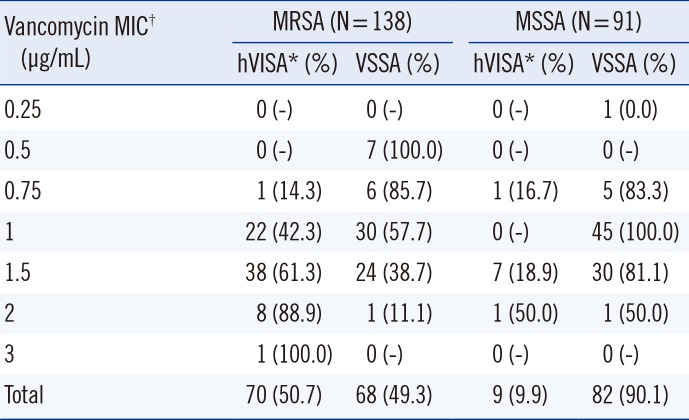
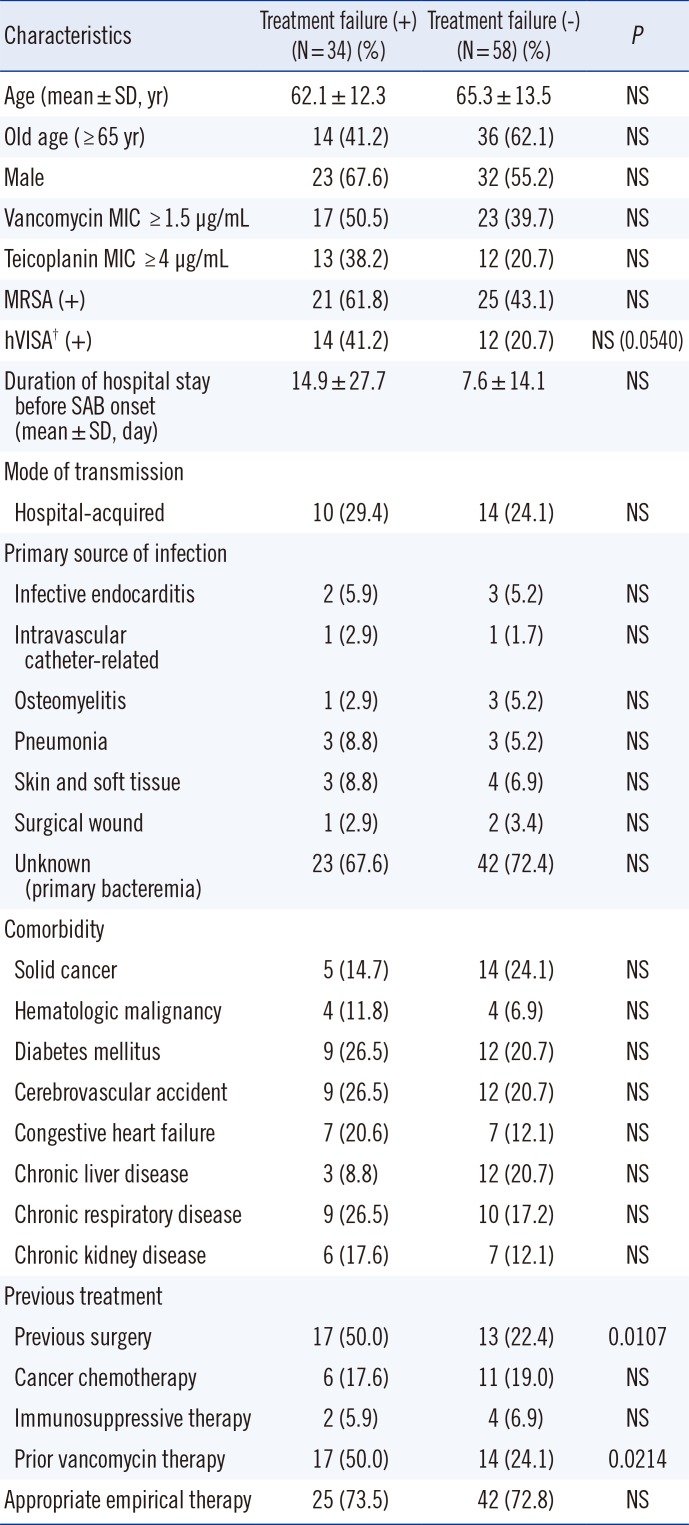
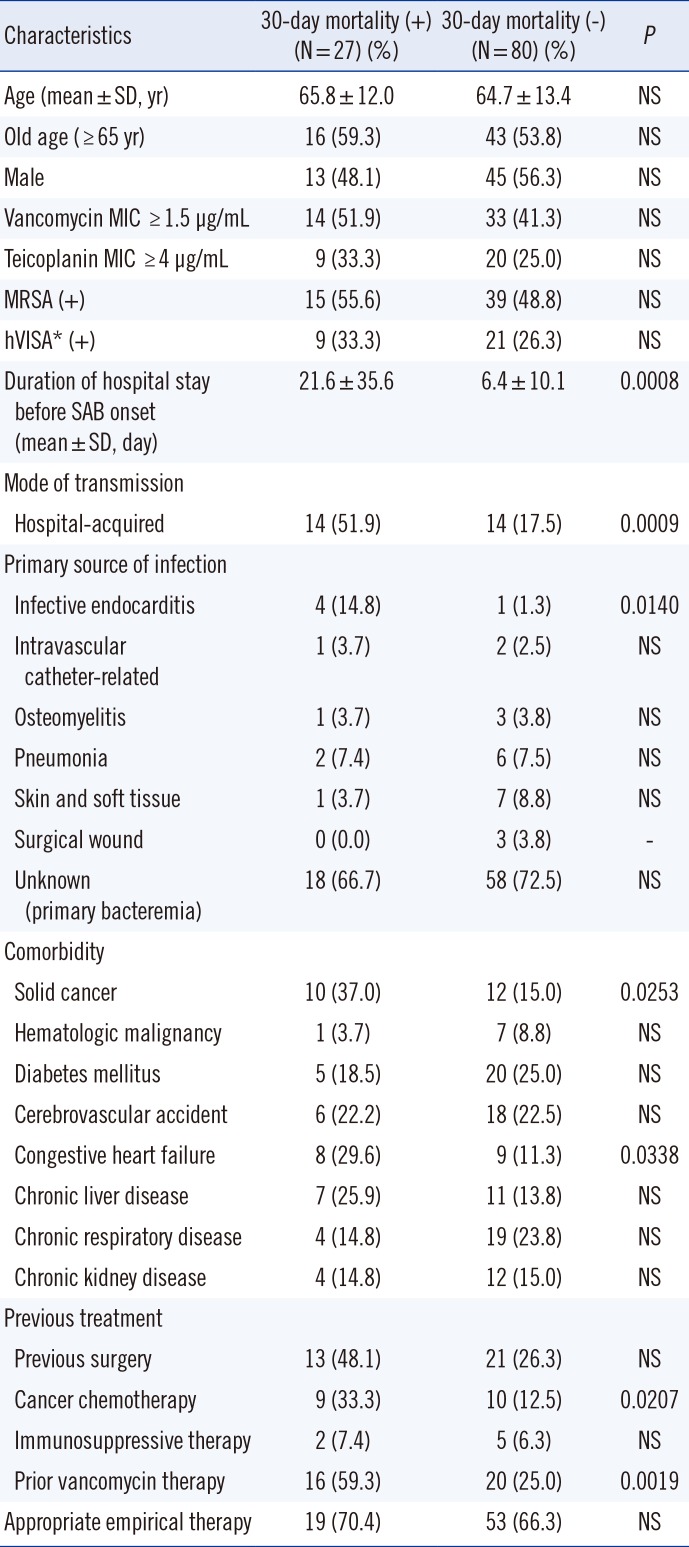
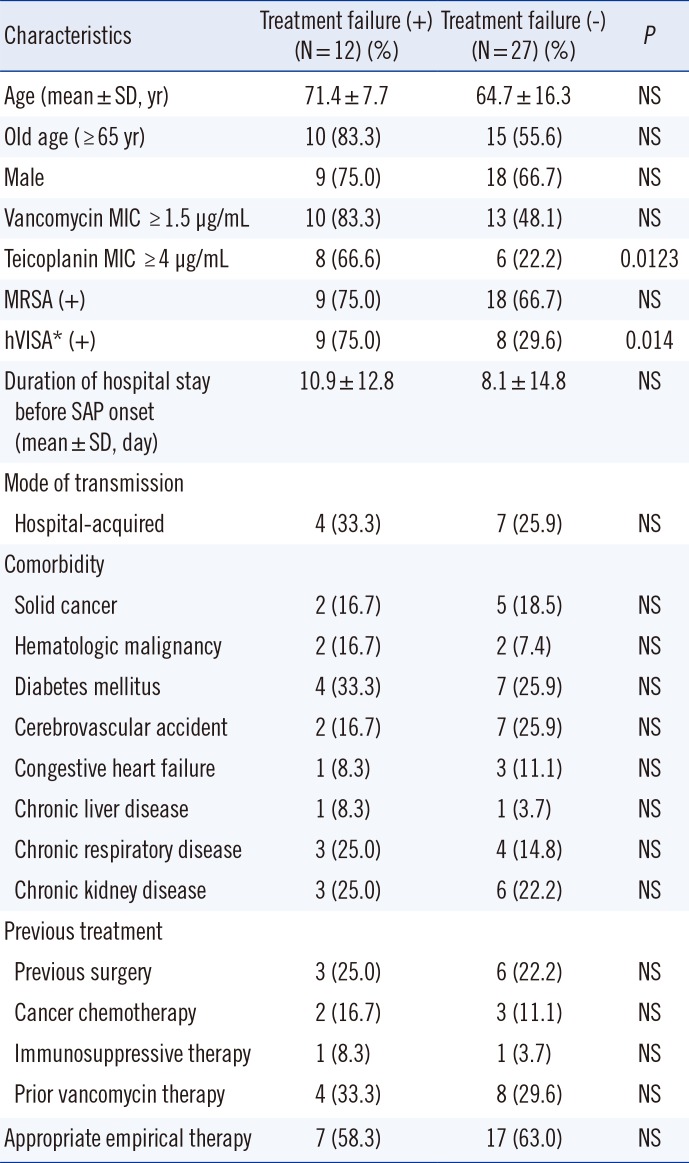
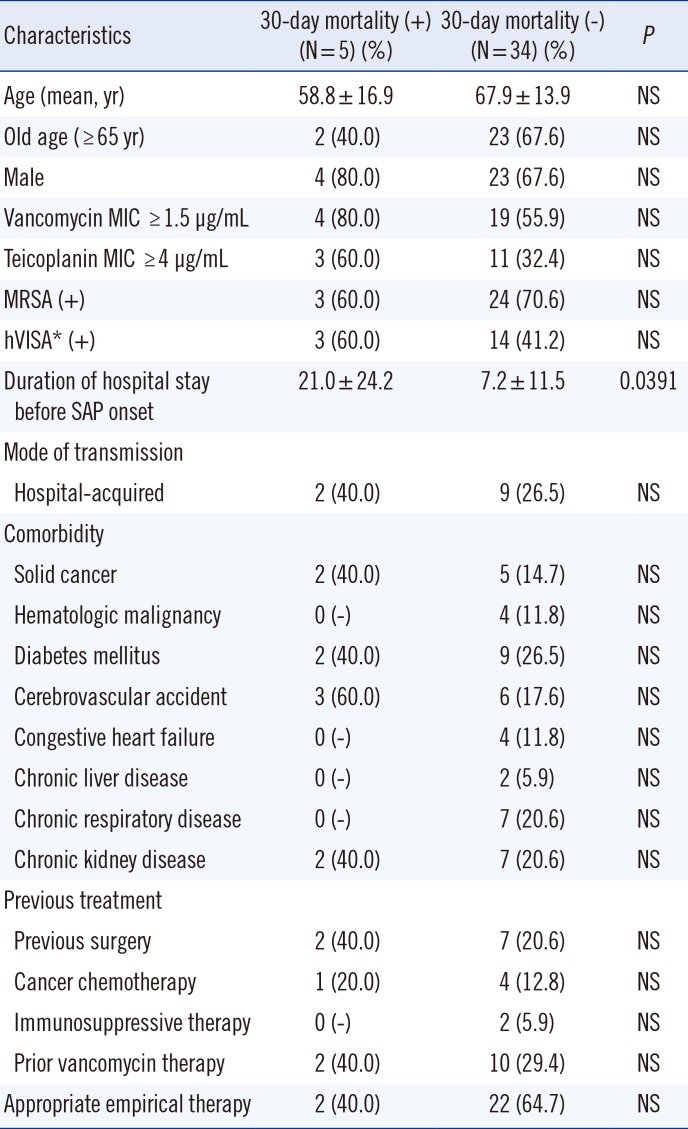




 PDF
PDF ePub
ePub Citation
Citation Print
Print



 XML Download
XML Download